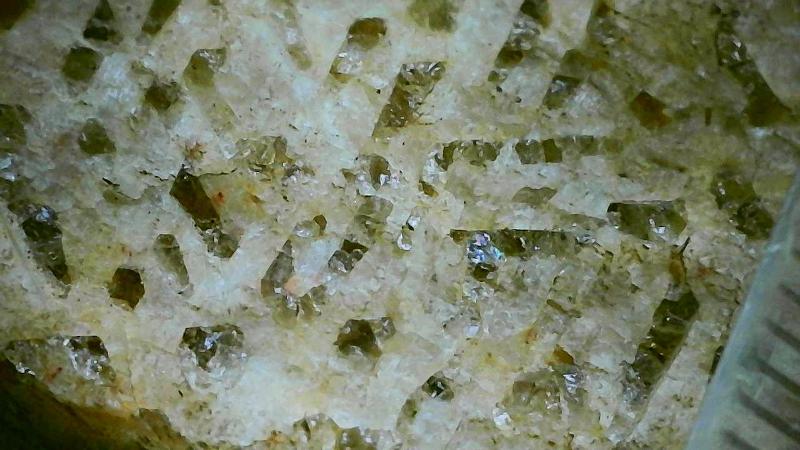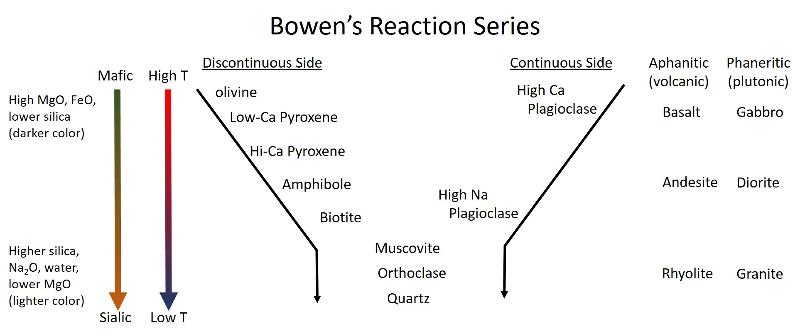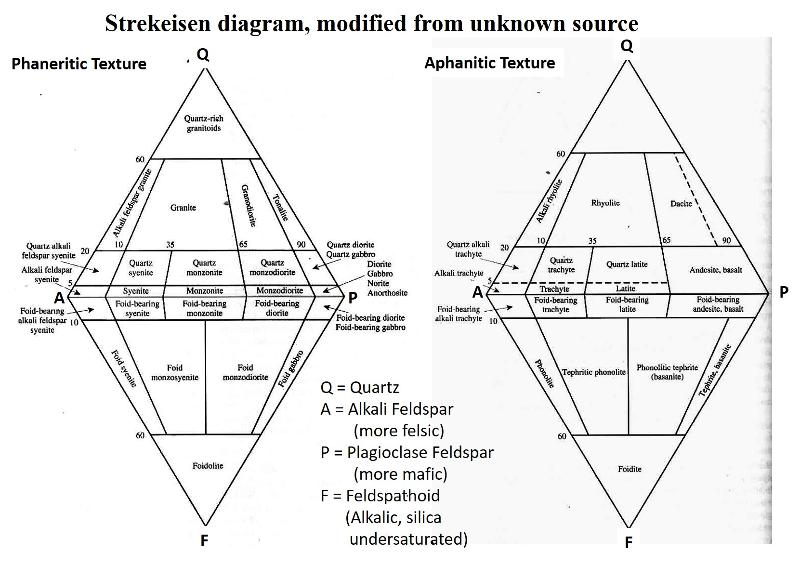
Earth Science Extras
by Russ Colson

Graphic intergrowth of quartz and K-feldspar, one of the features that can be seen in hand sample that tells a story of the rock's formation.
This exercise is intended to provide you with practice and insight into
The emphasis is not on detailed and complicated interpretations of each rock, something that often requires more information from regional context, microscopic study, chemical analysis, mineralogical analysis, stratigraphic relationships, and so on than you can get from a hand sample (or the pictures in this lesson), but rather on identifying the basic stories told by the textures and minerals of the rock. For igneous rocks, these mostly fall into two categories:
In simple summary, aphanitic rocks indicate rapid cooling after volcanic extrusion to the surface whereas phaneritic rocks indicate slow cooling at depth in the crust. Mafic compositions are more typical of divergent boundaries or hot spot activity, andesitic compositions are more typical of subduction boundaries, highly felsic compositions are more typical of continental vs oceanic origin, and silica-undersaturated compositions are more typical of continental divergence. We will use these simplifications in this lesson even though there are many complexities to the stories real rocks tell.
In these exercises, you can often figure out the 'answer' through context and simple clues, but the hope is that you pay attention to all of the observations and interpretations that are listed in the answers (and feedback) so as to hone your ablity to notice those features and to practice your ability to make interpretations of those features. There are quite a few "options" in the multiple choice answers, which hopefully encourages you to slow down and think about each rock in particular, what its features are and what stories those features tell. This lesson is not intended to be zipped through in an hour.
This lesson does not provide an introduction to igneous rocks. It is expected that you already know the basics of rock types and how to recognize textures, minerals, and tell stories from them.
The pictures provided are intended to approximate what you can see in an actual hand sample, where sometimes key features like cleavage, crystal form, etc are not quite visible. Of course, you can rotate a real sample in the light and get more information based on how what you see changes as you turn it, seeing glints off cleavage planes and getting a better sense of its three-dimensional character. However, knowing what to look for can often help you spot important features that are present in a hand sample, and this lesson provides some prompts to help with notcing some of the important features that might offer guidance in what to look for when looking at a real hand sample.
Although naming the rocks is almost an incidental part of this lesson (given less importance than noticing and interpreting features), here are some classification charts to help you get oriented in naming the rocks. You might read over these so as to have a familiarity with igneous rock types and how they differ.
Bowen's Reaction Series below provides a framework for understanding the most common igneous rock types in terms of their color (whether dark or light minerals dominate), the minerals to expect in each, and the relationships among them in terms of how 'evolved' or 'primitive' the rocks are (more mafic compositions being more primitive and less evolved, representing a higher temperature, less-crystallized state of a magma).

Common igneous rock types not shown in this diagram include the following:
The Streckeisen diagram, below, is the standard classification chart for igneous rocks, including less common rock types, such as the alkalic (silica undersaturated) rocks. In general, you won't need this diagram to name the rocks in the exercises below, but this diagram provides context for the rock names and what they mean in terms of composition.

There are some additional rock types that contain only 1 or 2 dominant minerals, most commonly formed by accumulation (a cumulate rock). These include the following:
Read each option carefully (yes, this will take time, that's the point). Some answers are very similar with only slight differences, and you will often need to read through all answers to determine which one is most suited to the rock in question. Alos, think about the feedback to the interpretation of what each rock tells us.
last updated 11/13/2022. Text and pictures are the property of Russ Colson, except as noted.